Public Toilets Case Studies with Pratt Institute: Sydney, Australia
Written by MFA student Jean Juan with Margot Kleinman
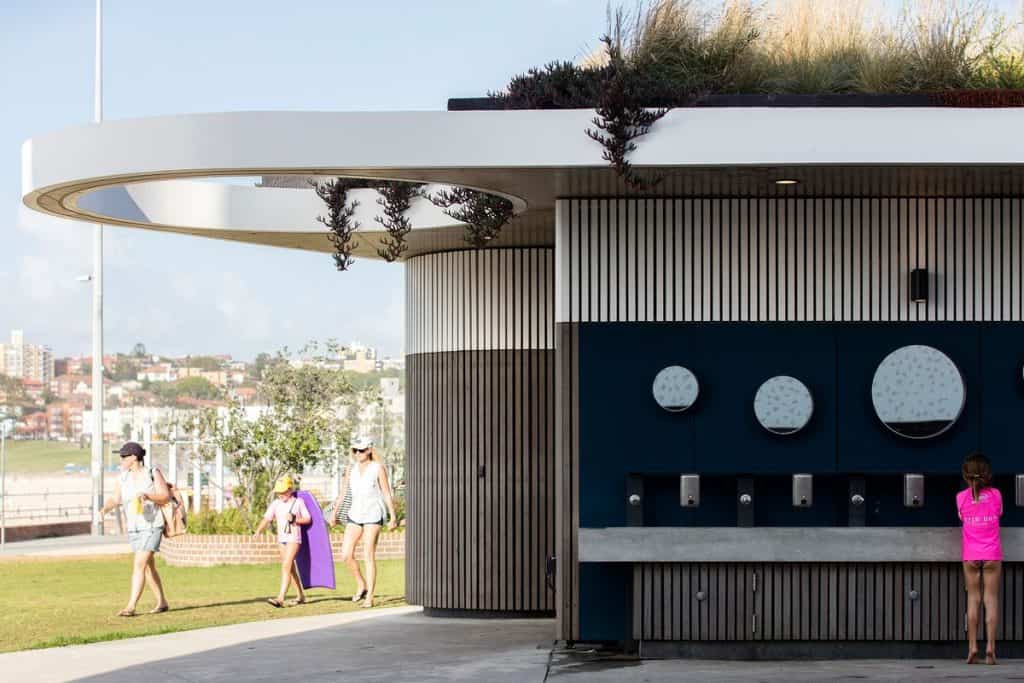
North Bondi Beach Restroom
The City of Sydney, one of Australia’s largest and fastest-growing local areas, has an estimated population of 5.2 million in 2024. (https://worldpopulationreview.com/world-cities/sydney-population). In the 2022/23 financial year, the city hosted 5.4 million international and domestic overnight visitors in commercial accommodation. (https://www.cityofsydney.nsw.gov.au/guides/city-at-a-glance)
With so many locals and tourists engaging in Sydney’s vibrant outdoor and active lifestyle culture, such as walking, cycling, beach outings, and attending outdoor events and festivals, the city’s public spaces, parks, and beaches are integral to its culture. Providing public toilets in these recreational spaces allows more people to enjoy outdoor activities comfortably, especially for children, seniors and people with medical conditions. The city has been working for the last ten years to ensure that public restrooms are available and accessible to support the diverse range of activities enjoyed by residents and visitors.
A critical question we need to ask is “what makes a toilet truly publicly accessible?”. The City of Sydney defines public toilets in their 2014 Strategy as toilet facilities which are directly accessible to the public including those located in parks, on streets, in some City-managed public buildings, at some rail stations and in shopping centres. (https://www.cityofsydney.nsw.gov.au/strategies-action-plans/public-toilet-strategy)
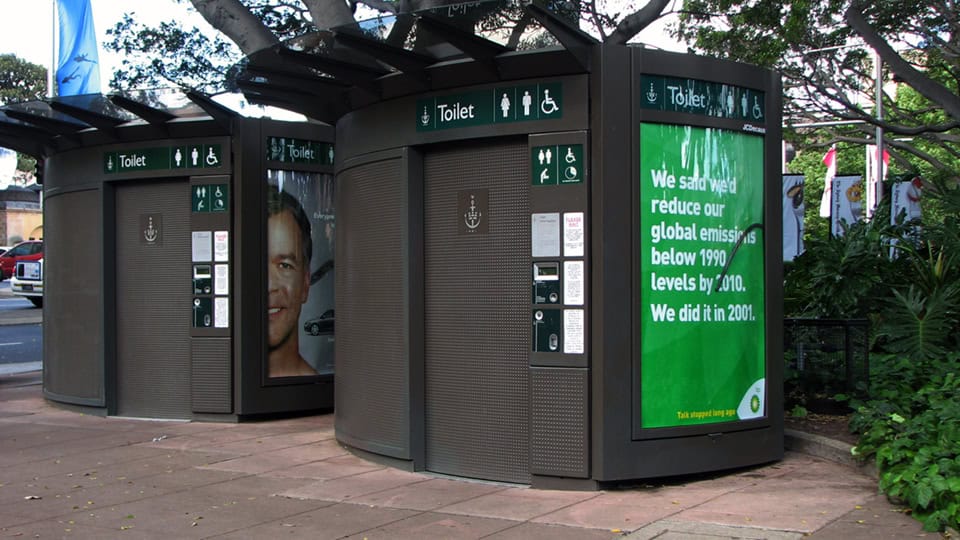
Sydney’s Automated Public Toilets by JCDecaux to be made free of charge
City of Sydney Public Toilet Strategy 2014
The City of Sydney’s Public Toilet Strategy 2014 focuses on enhancing public restroom provision by increasing the number of facilities in high-demand areas. Additional restrooms aim to improve accessibility for all users, and ensure high maintenance and cleanliness standards. The strategy emphasizes using technology and innovative designs for better functionality and sustainability.
The plan also addresses the city’s residents’ and visitors’ current and future needs with suggestions, recommendations, and detailed plans. It includes a range of statistics of usage and comments from the public about public restroom use and experience. The majority of comments about the distribution of toilets indicated that additional toilets were needed and that toilets were difficult to find. Residents need more public restrooms for circumstances that may cause them to be reluctant to travel or partake in social activities where public facilities are lacking.
The current network often fails to meet the demand from visitors to entertainment precincts late at night, particularly on weekends. Increasing the availability of public toilets at night supports the city’s nighttime activity by providing essential amenities for a wide range of visitors. The predominant comments about operational hours was that they should be open 24 hours or they close too early. Within the strategy, the City’s vision is for a: “highly regarded, safe and accessible network of public toilets to meet the current and future needs of a world-class city.” https://www.cityofsydney.nsw.gov.au/strategies-action-plans/public-toilet-strategy
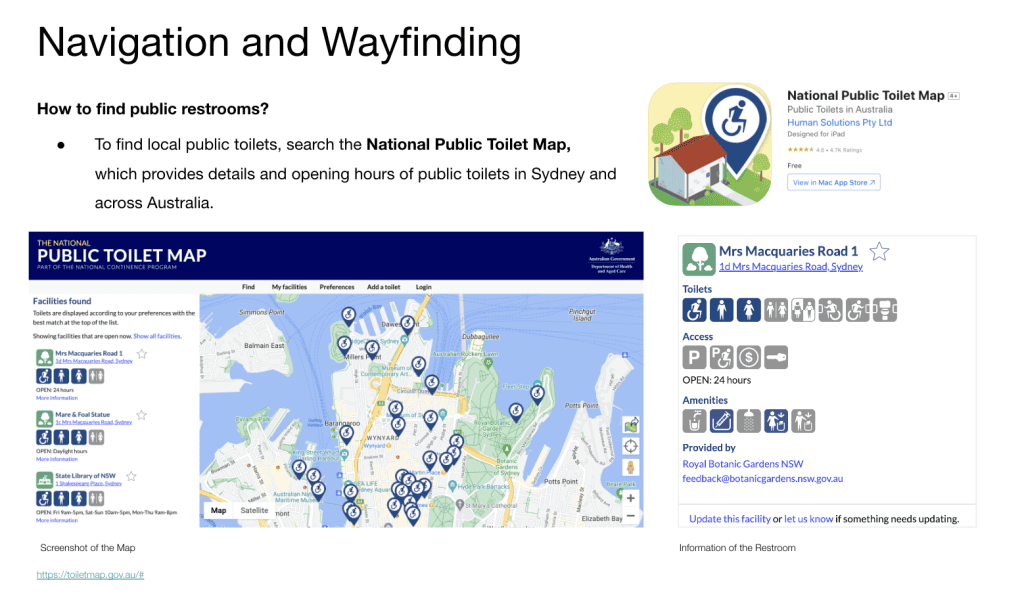
Student Jean Juan’s research on the National Public Toilet Map, highlighting Sydney Restrooms and amenities
The National Public Toilet Map
The National Public Toilet Map website and app is a comprehensive tool designed to help users locate public restrooms across Australia. Launched in 2001 as part of the National Continence Management Strategy, the map provides detailed information on over 23,000 publicly available toilets across Australia. Users can search for facilities by location, with filters for features such as accessibility, baby change facilities, opening hours, and more. (The National Public Toilet Map) The interactive map interface allows for easy navigation and planning, ensuring that individuals can find convenient and suitable restroom options when needed. https://toiletmap.gov.au/about
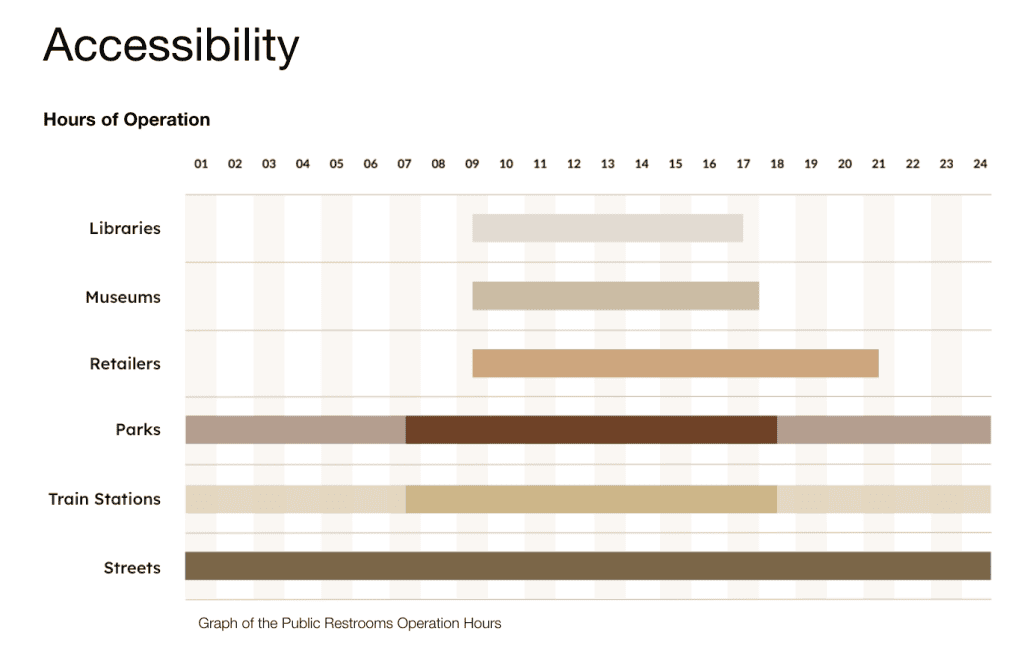
Diagram by Jean Juan showing hours of operation of public restrooms in Sydney, highlighting that only some are open 24 hours.
Based on the City of Sydney information, public restrooms available at night are located on the streets, in train stations, parks, or in council-operated automated public restrooms, while other restrooms typically close at sunset.
Automated Public Restroom
In Central Sydney and entertainment areas, the demand for public toilets is particularly high in the evenings when other facilities, like those in shopping centers, are closed. To meet this need, the plan is to ensure that public toilets are available within 400 meters, or a quarter of a mile, of any point in Central Sydney, village centers, and major neighborhood parks with large playgrounds and outdoor recreation facilities. (Public Restroom Strategy 2014 Handbook)
The planned automated public toilets will be inclusive and wheelchair accessible, with additional ambulant-accessible cubicles in high-demand areas. They will feature advanced safety and hygiene technology, including self-cleaning mechanisms, automated doors, and emergency security provisions. Maintenance staff will clean and service the facilities twice daily, and usage will be limited to 10-15 minutes to prevent loitering. (City of Sydney: New Automatic Public Toilets) . While the automated public toilets are single use and gender inclusive, the City’s survey of public toilet users indicates a community preference, especially by females, for single-sex facilities. https://www.cityofsydney.nsw.gov.au/strategies-action-plans/public-toilet-strategy https://www.cityofsydney.nsw.gov.au/improving-streets-public-spaces/new-automatic-public-toilets-2021-22
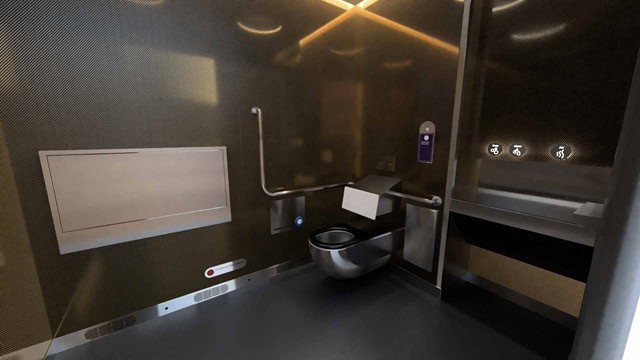
Interior of the new automated public toilets showing wheelchair circulation space and transfer rails, wheelchair accessible sink with sensor operated taps and fold-up baby change table.
Design Analysis
The design of the Automated Public Toilet (APT) enhances user experience by using reflective wall materials and skylight to create a spacious feel, sensor-activated dispensers for contactless use, a minimalist interior for simplicity, and Braille signage to assist visually impaired individuals. However, the design of the APT has some drawbacks, including dim lighting, a hard-to-reach emergency button, stressful automated timing, and insufficient signage or directional guidance, which makes it difficult for people to find restrooms easily. Fortunately, to address ease of finding a toilet, part of the strategy is to “Promote the public toilet network through a range of media including toilet maps, way-finding signage, accessible print and digital information including apps.”
Conclusion
Concerns about the lack of public restrooms in Sydney are mainly covered in the Public Toilet Strategy 2014 Handbook, and I was happy to see that there are no public complaints online while the city is continuously working on improvements. Sydney is effectively addressing the challenge by offering valuable tools like the National Public Toilet Map to help people locate public restrooms and proposing the introduction of more automated public restrooms for residents and visitors, free of charge. While the 2014 Strategy was aiming towards 2030, we look forward to seeing how the plan continues over the next six years.
If any readers have further insight on Sydney’s public toilets today or are interested in continuing the conversation, feel free to reach out to Margot Kleinman at mkleinma@pratt.edu. Continue following along to see the biweekly posts of research to learn more about public toilets design! All work included belongs to Pratt Institute.

